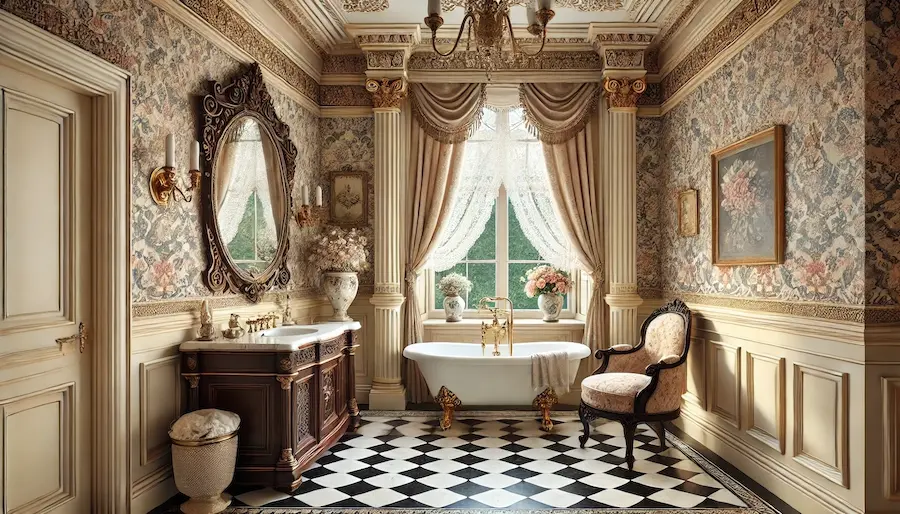Victorian bathrooms exude timeless elegance, characterized by ornate fixtures, rich materials, and intricate detailing. This article explores their origins, key features, applications, and considerations for incorporating Victorian elements into your bathroom.
Introduction to Victorian Bathrooms
The Victorian era (1837–1901) marked a significant transformation in domestic architecture and interior design, including the advent of dedicated bathrooms in affluent homes. These spaces combined functionality with opulence, featuring elaborate designs that reflected the period’s emphasis on luxury and attention to detail.
History and Origins of Victorian Bathrooms
Prior to the mid-19th century, bathing facilities were rudimentary, often consisting of portable tubs filled manually. The Victorian era introduced plumbed bathrooms, initially in wealthy households, revolutionizing personal hygiene. Advancements in plumbing and sanitation allowed for the development of permanent bathroom fixtures, such as freestanding roll-top baths and pedestal sinks, which became hallmarks of Victorian design.
Key Features of Victorian Bathrooms
Incorporating Victorian elements can transform a bathroom into a luxurious retreat:
- Freestanding Bathtubs: Clawfoot or roll-top tubs serve as focal points, epitomizing Victorian luxury. These tubs often feature ornate feet and are crafted from cast iron or porcelain.
- Pedestal Sinks: Elegant pedestal sinks with porcelain basins and decorative detailing reflect the era’s emphasis on sophistication. They often include cross-handle faucets and exposed plumbing in polished metals.
- Ornate Fixtures: Brass or gold-finished faucets, towel rails, and light fixtures add a touch of opulence. Intricate designs and polished finishes are characteristic of Victorian hardware.
- Patterned Flooring: Mosaic tiles or encaustic patterns in monochromatic schemes provide visual interest and authenticity. Black and white checkerboard patterns were particularly popular during this era.
- Decorative Millwork: Wainscoting, crown molding, and decorative trim enhance the room’s elegance, reflecting the Victorian attention to detail. These elements often feature intricate carvings and are painted in complementary colors.
Applications of Victorian Bathrooms
Victorian bathroom designs can be adapted to various settings:
- Historic Homes: Restoring a bathroom with authentic Victorian elements preserves the property’s historical integrity. Utilizing period-appropriate fixtures and materials can enhance the home’s value and charm.
- Modern Residences: Incorporating Victorian features adds a touch of classic elegance, creating a unique blend of old and new. For example, pairing a clawfoot tub with contemporary lighting can achieve a harmonious balance.
- Boutique Hotels and Spas: Victorian-inspired bathrooms offer guests a luxurious and nostalgic experience, enhancing the establishment’s appeal. Attention to detail in design can create a memorable and indulgent atmosphere.
Considerations When Choosing Victorian Bathroom Elements
When designing a Victorian bathroom, consider the following:
- Authenticity: Sourcing antique or reproduction fixtures ensures historical accuracy and adds to the room’s charm. Authentic pieces can often be found at architectural salvage yards or specialty retailers.
- Maintenance: Ornate fixtures and finishes may require regular upkeep to maintain their luster and prevent tarnish. Selecting high-quality materials and proper cleaning can prolong the beauty of these elements.
- Space Constraints: Freestanding tubs and pedestal sinks require adequate space; ensure the room’s dimensions can accommodate these features comfortably. Proper planning can prevent overcrowding and maintain functionality.
- Modern Amenities: While maintaining historical aesthetics, incorporate contemporary conveniences discreetly to meet current standards of comfort and efficiency. For instance, modern plumbing can be concealed within period-style cabinetry.
Conclusion
Victorian bathrooms offer a blend of historical charm and luxurious elegance. By understanding their origins and key features, you can create a bathroom that reflects the opulence of the Victorian era while accommodating modern needs, resulting in a timeless and inviting space.
